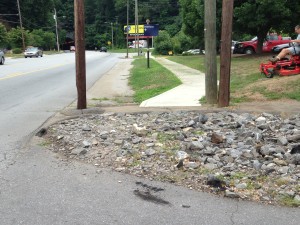North Carolina’s Strategic Transportation Investments (STI) law has made funding a small town bypass easier than funding a sidewalk in that very same downtown.
Read that again: North Carolina’s Strategic Transportation Investments law has made funding a small town bypass easier than funding a sidewalk in that very same downtown.
Let that sink it in for a second.

It is easier in NC to fund a highway bypass than it is to fund new sidewalks.
I recently spent two hours at a meeting going over a list of projects to help a region determine which projects would stay in the database used to score projects under the law and which projects would be removed. There were several stories about removal of pedestrian or greenway projects from that database because small towns cannot afford to pay the local match.
North Carolina’s General Assembly eliminated state funding for standalone Complete Streets projects with the 2013 passage of STI. It amounted to roughly $2 million a year and served as a vital lifeline to communities in need, especially small towns.
For projects in the more urbanized areas that are primarily complete streets-focused, we spent a lot of time discussing how DOT and planning organization representatives could code them into the ranking database in a category that didn’t fit what they really were. It turns out that the selection of a different category from a dropdown box can lead to higher project scores. This is because the entire ranking process is geared toward giving the highest number of points to projects that add capacity.
The idea is: let’s call something capacity even if it’s not really about capacity because that will get a higher score. Once it’s funded in the Statewide Transportation Improvement Program we can change the project to suit the original intended purpose (and this has led to project cost increases on some highway project of $20 million up to $200 million without any public review or reevaluation of the project).
Toward the end of the meeting we addressed projects in a rural county. A project under consideration was an $8.7 million highway bypass of a town of 1,900. No problem. If that project made the STIP, the town would not have to pay a penny to have it fully funded and maintained in perpetuity by the citizens of North Carolina.
But this town’s leaders have different desires. They told the planning organization they didn’t want people to bypass their downtown. Instead they wanted to submit a project to fund sidewalks in their downtown.
Problem is: they are on the hook to pay for 20% of that project. Meanwhile, the state will gladly pay all of the $8.7 million bypass project, which adds lane miles to a system where the constant refrain is we don’t have enough money to maintain the roads we have.
The discussion then centered on how the planning organization had reached its limit of projects it could submit to the ranking database under the bicycle and pedestrian category. This meant that another Complete Street project from another municipality in another county must be removed from consideration.
Luckily, the local DOT office stepped in and said they would submit it under their list.
The DOT divisions in our region have been working to creatively help communities navigate the STI-mandated process to attempt to fund Complete Streets projects. For that they should be applauded. I’ve heard similar stories from across the state.
But I can’t help but feel this is gaming the system and once it is discovered by a General Assembly that is not supportive of walking and bicycling, the consequences will be much more catastrophic than the elimination of $2 million a year in state funding to match projects.
Perhaps you know of communities in your region of contacts that had to face the same realities of the small town I describe above. Many have been forced to to forego investments in to improve economic and health conditions in their community because they couldn’t afford to pay for it. Yet building a bypass of their downtown is now much easier.
It shouldn’t be that way.
